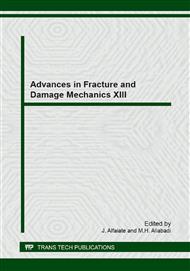[1]
Cisilino A.P. (Universidad Nacional de Mar del, Plata-CONICET, Mar del Plata, Argentina); Aliabadi M.H.; Otegui J.L. (1998): Three-dimensional boundary element formulation for the elastoplastic analysis of cracked bodies. Int J Numer Meth Eng, vol. 42, n. 2, pp.237-256.
DOI: 10.1002/(sici)1097-0207(19980530)42:2<237::aid-nme359>3.0.co;2-6
Google Scholar
[2]
Caputo F.; Lamanna G.; Soprano A. (2013): On the evaluation of the plastic zone size at the crack tip. Eng Fract Mech, vol. 103, p.162–173.
DOI: 10.1016/j.engfracmech.2012.09.030
Google Scholar
[3]
Leitao V.M.A. (Inst. Superior Tecnico, Lisbon, Portugal); Aliabadi M.H.; Rooke D.P. (1995): Elastoplastic simulation of fatigue crack growth. Dual boundary element formulation. Int J Fatigue, vol. 17, n. 5, pp.353-63.
DOI: 10.1016/0142-1123(95)99736-t
Google Scholar
[4]
Broberg K. B. (1999): Cracks and Fracture, Academic Press.
Google Scholar
[5]
Werner K. (2012): The fatigue crack growth rate and crack opening displacement in 18G2A-steel under tension, Int J Fatigue, vol. 39, p.25–31.
DOI: 10.1016/j.ijfatigue.2011.06.005
Google Scholar
[6]
Caputo F.; Lamanna G.; Soprano A. (2006): Numerical Investigation on the Crack Propagation in a Flat Stiffened Panel. Key Eng Mat, vol. 324-325, pp.559-562.
DOI: 10.4028/www.scientific.net/kem.324-325.1039
Google Scholar
[7]
Camas D.; Garcia-Manrique J.; Gonzalez-Herrera A. (2011): Numerical study of the thickness transition in bi-dimensional specimen cracks. Int J Fatigue, vol. 33, n. 7, p.921–928.
DOI: 10.1016/j.ijfatigue.2011.02.006
Google Scholar
[8]
Lados D. A.; Apelian D. (2008): Relationships between microstructure and fatigue crack propagation paths in Al-Si-Mg cast alloys. Eng Fract Mech, vol. 75, p.821–832.
DOI: 10.1016/j.engfracmech.2007.01.027
Google Scholar
[9]
Caputo F.; Lamanna G.; Lanzillo L.; Soprano A. (2014): Numerical investigation on LEFM limits under LSY conditions. Key Eng Mat, vol. 577-578, pp.381-384.
DOI: 10.4028/www.scientific.net/kem.577-578.381
Google Scholar
[10]
Caputo F.; Lamanna G.; Soprano A. (2013): Residual Strength Improvement of an Aluminium Alloy Cracked Panel. The Open Mechanical Engineering Journal, vol. 7, pp.90-97.
DOI: 10.2174/1874155x20131023001
Google Scholar
[11]
Caputo F.; Lamanna G.; Soprano A. (2012): Geometrical parameters influencing a hybrid mechanical coupling, Key Eng Mat, vol. 525-526, pp.161-164.
DOI: 10.4028/www.scientific.net/kem.525-526.161
Google Scholar
[12]
Caputo F.; Lamanna G.; Soprano A. (2012): Effects of Tolerances on the Structural Behavior of a Bolted Hybrid Joint, Key Eng Mat, vol. 488-489, pp.565-569.
DOI: 10.4028/www.scientific.net/kem.488-489.565
Google Scholar
[13]
Caputo F.; Lamanna G.; Soprano A. (2011): Numerical modeling and simulation of a bolted hybrid joint. Structural Durability and Health Monitoring, vol. 7 (4), pp.283-296.
Google Scholar
[14]
Lamanna G.; Caputo F.; Soprano A. (2012): Handling of composite-metal interface in a hybrid mechanical coupling. AIP Conference Proceedings, vol. 1459, pp.353-355.
DOI: 10.1063/1.4738494
Google Scholar
[15]
Caputo F.; Di Felice G.; Lamanna G.; Lefons A.; Riccio A. (2013): Numerical procedures for damage mechanisms analysis in CFRP composites. Key Eng Mat, vol. 569-570, pp.111-118.
DOI: 10.4028/www.scientific.net/kem.569-570.111
Google Scholar
[16]
Leitao V. (Wessex Inst. of Technol., Portsmouth Univ., Ashurst, UK); Aliabadi M.H.; Rooke D.P. (1995): The dual boundary element formulation for elastoplastic fracture mechanics. Int J Numer Meth Eng, vol. 38, n. 2, pp.315-33.
DOI: 10.1002/nme.1620380210
Google Scholar
[17]
Armentani E.; Citarella R.; Sepe R. (2011). FML Full Scale Aeronautic Panel Under Multiaxial Fatigue: Experimental Test and DBEM Simulation. Eng Fract Mech, vol. 78, pp.1717-1728.
DOI: 10.1016/j.engfracmech.2011.02.020
Google Scholar
[18]
Sfantos G.K., Aliabadi M.H. (2007): Multi-scale boundary element modelling of material degradation and fracture. Comput Method Appl M, vol. 196, n. 7, pp.1310-29.
DOI: 10.1016/j.cma.2006.09.004
Google Scholar
[19]
Cisilino A.P. (Universidad Natl de Mar del Plata, Mar del Plata, Argentina); Aliabadi M.H. (1999): Three-dimensional boundary element analysis of fatigue crack growth in linear and non-linear fracture problems. Eng Fract Mech, vol. 63, n. 6, pp.713-33.
DOI: 10.1016/s0013-7944(99)00047-8
Google Scholar
[20]
Citarella R.; Cricrì G.; Armentani E. (2013): Multiple crack propagation with Dual Boundary Element Method in stiffened and reinforced full scale aeronautic panels. Key Eng. Mat., vol. 560, pp.129-155.
DOI: 10.4028/www.scientific.net/kem.560.129
Google Scholar
[21]
Caputo F.; Lamanna G.; Soprano A. (2011): An Analytical Formulation for the Plastic Deformation at the Tip of Short Cracks. Proceedia Engineering, vol. 10, p.2988–2993.
DOI: 10.1016/j.proeng.2011.04.495
Google Scholar
[22]
Jin O.; Mall S. (2003): Effects of microstructure on short crack growth behavior of Ti–6Al–2Sn–4Zr–2Mo–0.1Si alloy. Mater Sci Eng, vol. 359, p.356–367.
DOI: 10.1016/s0921-5093(03)00377-0
Google Scholar
[23]
Hussain K. (1997): Short fatigue crack behavior and analytical models: a review. Eng Fract Mech, vol. 58, p.327–54.
Google Scholar


